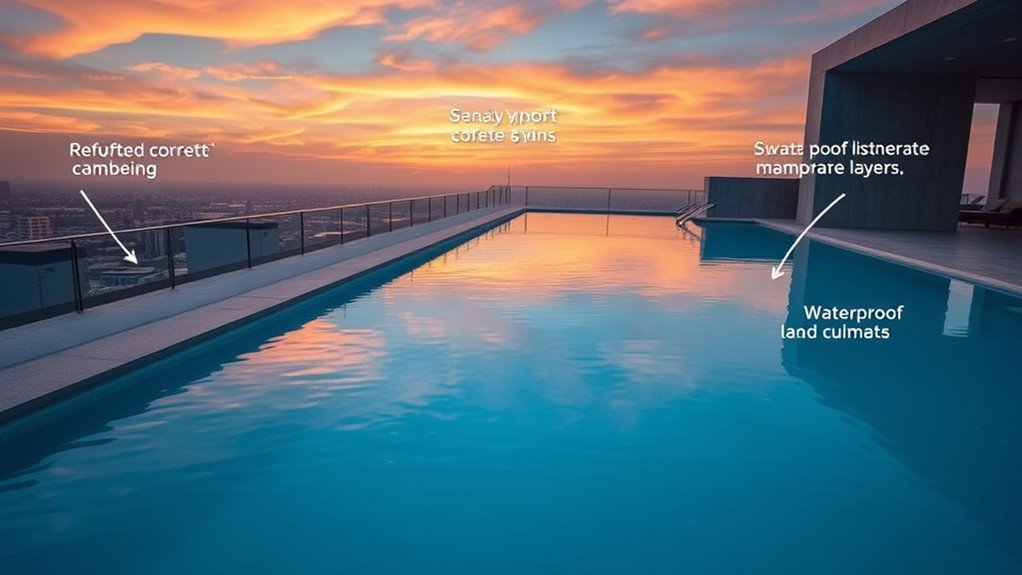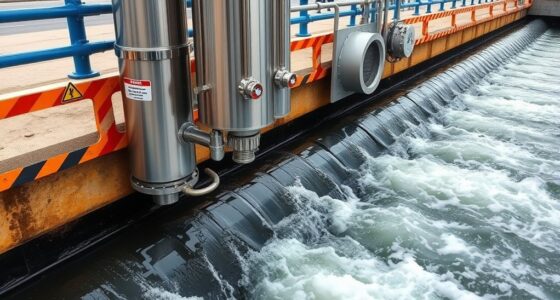When designing or maintaining a rooftop infinity pool, you need to take into account structural load, vibration, and waterproofing fundamentals. Understand that water weight and pool contents add significant live loads, requiring strong support and possible reinforcement. Vibrations from equipment or external traffic can cause damage if not controlled with damping systems. Proper waterproofing, using seamless membranes and sealants, prevents leaks and prolongs durability. Keep these basics in mind to guarantee safety and longevity—more details wait just ahead.
Key Takeaways
- Structural support must be assessed and reinforced to handle the combined dead and live loads of the pool and water.
- Proper vibration mitigation techniques, such as damping systems and flexible mounting, prevent resonance and structural damage.
- Waterproofing requires seamless, durable membranes like liquid-applied or sheet materials, with thorough sealing of joints and penetrations.
- Regular maintenance, including inspections and sealant reapplications, prolongs waterproofing integrity and prevents leaks.
- Incorporating expansion joints and flexible sealants accommodates thermal movement and vibration, ensuring long-term stability.
Understanding Structural Load Requirements for Rooftop Pools

Before installing a rooftop infinity pool, it’s essential to comprehend the structural load requirements to guarantee safety and stability. Your building’s foundation and support structure must handle the weight of the filled pool, including water, equipment, and occupants. You need to assess the existing load-bearing capacity of your rooftop to prevent structural failure. This involves understanding the maximum live load your structure can support and ensuring it exceeds the pool’s total weight. Reinforcements might be necessary if your current structure isn’t designed for such heavy loads. Ignoring these requirements can lead to catastrophic consequences, like cracks or collapse. Consulting with a structural engineer is vital to evaluate your building’s capacity and develop a safe, effective plan for supporting your rooftop infinity pool. Additionally, understanding personal growth principles can help you better manage the planning and decision-making process involved in such a significant construction project.
Calculating Dead and Live Loads for Pool Construction

Calculating the dead and live loads is a critical step in designing a safe rooftop infinity pool. Dead loads include the weight of the pool structure, waterproofing, and permanent fixtures, which you determine based on material specifications. Live loads cover the weight of water, occupancy, equipment, and maintenance activities. To accurately estimate these, you need to consider the pool’s dimensions, water depth, and additional features like lighting or decking. Use building codes and load tables to ensure your calculations meet safety standards. Properly evaluating these loads helps you design a structure that can support the weight without risking failure. Additionally, understanding essential oils for waterproofing can contribute to the longevity of your pool’s waterproof layers. Properly evaluating these loads prevents overloading and ensures long-term stability of your rooftop pool.
The Impact of Water Weight and Pool Contents on Building Stability

Understanding how water weight and pool contents affect building stability is essential when designing a rooftop infinity pool. Water is extremely heavy, with about 8.34 pounds per gallon, so even small pools add significant load. You must account for this weight in your structural calculations to prevent overloading the building’s foundation. Additionally, pool contents like pool equipment, chemicals, and accumulated debris contribute to the overall weight and can affect balance if unevenly distributed. Proper load distribution ensures the building’s stability, especially on rooftops where support structures are more limited. Regular inspection and maintenance of the support system are also critical to prevent structural failure over time. Neglecting these factors risks structural failure, cracks, or even collapse. Careful assessment of water volume, contents, and load transfer pathways helps you maintain safety and integrity over the pool’s lifespan.
Vibration Sources and Their Effects on Rooftop Pool Structures

Vibrations from nearby equipment or traffic can cause structural resonance in your rooftop pool. These vibrations may lead to increased stress on the pool’s structure over time. Understanding how equipment-induced vibrations affect stability is vital for maintaining safety and longevity. Incorporating sound design principles can help identify and mitigate problematic noise and vibration sources before they cause damage.
Structural Resonance Risks
Structural resonance poses a significant risk to rooftop infinity pools because certain vibration sources can amplify these structures’ natural frequencies, leading to potential damage or failure. When external forces, like wind or nearby heavy traffic, match the pool’s natural frequency, vibrations intensify. This resonance can cause excessive stresses in the pool’s concrete and waterproofing layers, risking cracks or structural compromise. You need to comprehend the importance of identifying the pool’s natural frequency during design and construction. If not properly addressed, resonance can lead to long-term durability issues, costly repairs, or even catastrophic failure. To mitigate this risk, incorporate damping systems, adjust structural stiffness, or modify pool geometry. Proper vibration analysis and proactive engineering measures are essential to ensure the pool remains stable under dynamic loads. Additionally, understanding AI security vulnerabilities can help engineers develop innovative safety features to monitor and control vibrations more effectively.
Equipment-Induced Vibrations
Equipment-induced vibrations are a significant concern for rooftop infinity pools because machinery such as pumps, HVAC systems, and filtration units generate dynamic forces that can transfer to the pool structure. These vibrations can cause discomfort, damage, or compromise waterproofing if not properly managed. To mitigate these effects, consider isolating equipment on vibration pads, incorporating flexible connections, and designing structural damping systems. Be aware that:
- Vibrations can amplify if equipment is unbalanced or improperly installed
- Resonance may occur if machinery frequencies match the structure’s natural frequency
- Long-term exposure can lead to fatigue in structural components
- Proper maintenance reduces unexpected vibration spikes and prolongs the lifespan of the pool and equipment
- Access to professional local expertise can help identify and address specific vibration issues effectively
Addressing equipment-induced vibrations is crucial for maintaining structural integrity and user comfort.
Methods to Minimize Structural Vibrations and Enhance Comfort

To create a comfortable rooftop infinity pool experience, it’s essential to implement effective methods for minimizing structural vibrations. One approach is to incorporate flexible mounting systems that absorb vibrations from equipment or external sources. You can also add damping layers, such as rubber or elastomeric pads, between the pool structure and supporting beams to reduce vibration transmission. Using reinforced concrete with proper reinforcement bars helps distribute loads evenly and dampen movements. Additionally, installing vibration isolators or shock absorbers at critical connection points prevents vibrations from traveling through the structure. Regular maintenance of all components ensures vibrations stay minimal over time. Implementing tire pressure adjustments and other techniques from gravel bike maintenance can also help reduce vibrations and improve overall comfort. By combining these strategies, you’ll substantially enhance comfort, prevent structural fatigue, and maintain the longevity of your rooftop infinity pool.
Waterproofing Materials Suitable for Rooftop Infinity Pools

Choosing the right waterproofing materials is essential for ensuring your rooftop infinity pool remains leak-free and durable over time. You need materials that resist water penetration, withstand weather conditions, and accommodate structural movement. Epoxy-based coatings are popular for their flexibility and chemical resistance. Liquid-applied membranes provide seamless coverage and easy repairs. PVC or TPO sheets are durable options for large surfaces, offering strong waterproof barriers. Spray-applied polyurethane membranes are versatile, quick to install, and highly adaptable to complex shapes. When selecting materials, consider factors like UV stability, adhesion properties, and compatibility with your pool’s construction. Proper application and quality materials prevent leaks, protect the structure, and extend your pool’s lifespan. Additionally, understanding the contrast ratio of your waterproofing system can help evaluate its effectiveness in various environmental conditions.
Designing Effective Waterproof Barriers and Sealing Techniques

Designing effective waterproof barriers and sealing techniques is essential for preventing leaks and ensuring the longevity of your rooftop infinity pool. You should start by choosing high-quality, compatible materials that form a continuous, seamless barrier. Proper joint design is important; verify all seams, corners, and transitions are thoroughly sealed using flexible, durable sealants. Pay close attention to details like penetrations for plumbing and drainage, sealing them meticulously to prevent water ingress. Use overlapping membranes where possible and reinforce critical areas with additional layers. Regular inspection and maintenance are necessary to identify and repair any damage or deterioration early. Incorporating mindfulness practices can help maintain focus and attention to detail during the installation process. By combining well-designed barriers with precise sealing techniques, you create a reliable waterproof system that withstands environmental stresses and prolonged exposure to water.
Addressing Thermal Expansion and Contraction in Waterproof Layers

You need to consider how your waterproof layers will handle temperature changes on a rooftop pool. Using flexible materials and proper expansion joints helps prevent cracks and leaks. Proper placement of these joints is vital to accommodate movement and maintain the pool’s integrity. Additionally, understanding legislative changes related to building codes can ensure your waterproofing strategies meet current standards.
Material Flexibility Strategies
To effectively manage thermal expansion and contraction in waterproof layers for rooftop infinity pools, incorporating material flexibility strategies is essential. Flexibility helps prevent cracks and delamination caused by temperature fluctuations. You can achieve this by selecting materials with inherent elasticity or adding bonding agents that accommodate movement. Using elastomeric coatings or membranes ensures the waterproof layer can stretch and contract without damage. Reinforcing layers with flexible fabric or mesh can also distribute stresses evenly. Proper surface preparation enhances adhesion, maintaining flexibility over time. Remember, choosing the right combination of flexible materials and installation techniques minimizes the risk of leaks and structural issues. Implementing these strategies ensures durability and longevity of your rooftop infinity pool’s waterproof system.
Expansion Joints Placement
Proper placement of expansion joints is crucial for accommodating thermal expansion and contraction in waterproof layers of rooftop infinity pools. You need to identify areas where temperature changes cause movement, such as edges, corners, and transitions between materials. Installing joints at these points allows the pool structure to expand or contract without cracking or damaging the waterproof membrane. You should space joints appropriately based on the size of the pool and expected temperature fluctuations, typically every 20 to 30 feet. Use flexible sealants or joint fillers compatible with waterproofing materials to guarantee watertight integrity. Proper placement and design of expansion joints help maintain the pool’s durability, prevent leaks, and accommodate structural shifts caused by temperature variations.
Maintenance Practices to Preserve Waterproof Integrity

Regular maintenance is essential for preserving the waterproof integrity of rooftop infinity pools. You should regularly inspect the waterproof membrane for signs of damage, such as cracks or blisters. Cleaning the surface and gutters prevents debris buildup that can cause water pooling and deterioration. Address any leaks immediately to prevent further damage. Keep an eye on expansion joints, ensuring they remain properly sealed. Additionally, maintain proper chemical balance to avoid corrosive effects on waterproofing materials.
Regularly inspect and maintain waterproof membranes to prevent damage and ensure pool longevity.
To enhance longevity, consider these practices:
- Conduct routine visual inspections of all waterproofing components
- Reapply sealants or coatings as recommended by manufacturers
- Remove standing water promptly after storms or heavy rain
- Schedule annual professional inspections to catch issues early
Case Studies of Successful Rooftop Infinity Pool Installations

Successful rooftop infinity pool installations showcase how innovative design and meticulous planning can turn challenging spaces into stunning amenities. These projects demonstrate that with the right structural support, waterproofing, and vibration control, you can create breathtaking features atop even the tallest buildings. For example, one hotel transformed a cramped rooftop into a luxurious retreat, inspiring awe in every guest. Another residential tower achieved perfection by integrating advanced load calculations, ensuring safety without sacrificing beauty. These case studies prove that careful engineering and attention to detail lead to success.
| Project Type | Key Achievement |
|---|---|
| Hotel Rooftop Pool | Stunning view with structural safety |
| Residential Tower Pool | Seamless integration with design |
| Commercial Complex Pool | Long-lasting waterproof integrity |
| Luxury Apartment Pool | Vibration control for comfort |
Frequently Asked Questions
How Do Weather Conditions Affect Rooftop Pool Waterproofing Longevity?
Weather conditions greatly impact your rooftop pool’s waterproofing longevity. Extreme temperatures cause expansion and contraction, which can crack the waterproof layers. Heavy rain and snow increase water pressure and potential for leaks. UV rays weaken waterproof membranes over time. To protect your pool, make certain proper waterproofing materials are used, and consider regular maintenance. Proper sealing and weather-resistant coatings help extend the lifespan of your rooftop pool’s waterproof system.
What Safety Measures Are Recommended for Rooftop Infinity Pool Maintenance?
You should always wear proper safety gear like gloves, goggles, and non-slip shoes when maintaining your rooftop infinity pool. Make certain the area is clear of hazards, use secure ladders or scaffolding, and avoid working alone. Regularly inspect for leaks, cracks, or loose fittings, and keep electrical equipment away from water. Follow manufacturer guidelines, and consider professional help for complex tasks to prevent accidents and ensure safe, effective maintenance.
How Does Pool Water Circulation Impact Structural Load Calculations?
Your pool’s water circulation directly influences structural load calculations because it impacts the weight distribution and dynamic forces on the roof. As water moves through pumps and jets, it creates additional vibrations and shifting loads. You need to take into account these factors in your structural design to guarantee stability and safety. Proper circulation system design minimizes uneven stress, reducing the risk of damage or failure over time.
Are There Eco-Friendly Waterproofing Options for Rooftop Pools?
Yes, you can choose eco-friendly waterproofing options for rooftop pools. Look for materials like liquid-applied membranes made from recycled or non-toxic components, or sheet membranes with environmentally friendly certifications. These options reduce chemical emissions and are safer for the environment. By selecting sustainable waterproofing, you help minimize your pool’s ecological footprint while maintaining durability and waterproof integrity, ensuring your rooftop remains both functional and eco-conscious.
What Are the Best Practices for Emergency Drainage in Rooftop Pools?
You should guarantee your rooftop pool has an emergency drainage system that’s easily accessible and clearly marked. Regularly inspect the drains for blockages, and keep backup outlets ready in case the primary drain fails. Test the system periodically to confirm it functions correctly, especially before heavy use or storms. Installing alarms or sensors can alert you to drainage issues early, helping prevent water overflow or structural damage.
Conclusion
By understanding load requirements, controlling vibrations, and implementing reliable waterproofing, you can guarantee your rooftop infinity pool remains safe and durable. For example, a recent project in downtown Chicago successfully integrated these principles, resulting in a stunning, maintenance-free pool that withstood seasonal temperature changes and heavy use. With careful planning and quality materials, you can enjoy your rooftop oasis without worries, knowing it’s built to last and impress.









